Menu
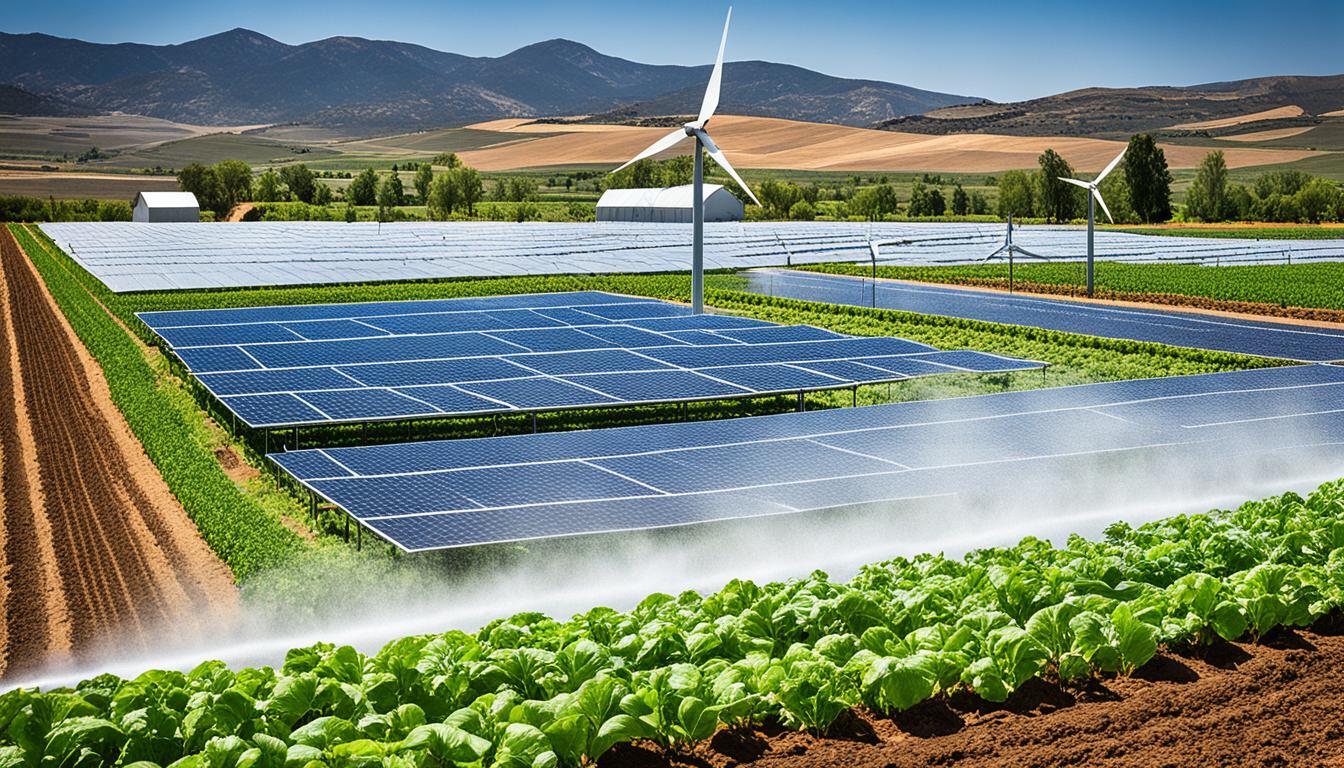
Every year, 12 million hectares of farmland face destruction from drought and desertification. This shows why sustainable farming is so crucial. With the severe effects of climate change, like droughts, farming must adapt to survive.
In striving for a better future, ADM leads the way. Their work helped more than 44,000 farmers and their families in 2020. These farmers now practice sustainable methods that improve food security, handle climate issues, and fight poverty. These changes are not only quick but also key for the future of farming.
Sustainable farming now stands as a key part of securing food and livelihoods against climate threats. By using smart farming techniques, we’re helping communities get stronger. This approach tackles today’s problems while aiming for a greener, more sustainable tomorrow.
It’s vital to back our local farmers for many reasons. They face challenges like dry spells and farming land loss. But, by using *ethical farming methods*, they can overcome these issues. This helps keep their farms sustainable. Plus, by supporting *local farming*, we improve our food safety. It also boosts our local economy and lessens our need for food from far away.
Local farmers struggle with many hurdles, from the weather changing fast to not having the latest farming tech. These challenges can hurt how much crop they get and the health of the soil. Using methods like cover cropping and not tilling so much helps keep the soil strong. It prevents it from washing away and stops pollution in the water. *Ethical farming practices*, thanks to groups like ADM, are key in helping our local farmers stay strong against these problems.
Getting behind local farmers has lots of upsides. For one, it makes our food supply safer with more crops to choose from. Sticking to earth-friendly ways also makes our communities more stable and ready for hard times. It even helps fight global warming by using less gas. This means a better balance in nature. Models like community-supported agriculture (CSA) also means more jobs and more money stays in the area.
| Practices | Benefits |
|---|---|
| Cover Cropping | Prevents soil erosion |
| Reduced Tillage | Enhances soil fertility |
| Diverse Cropping Systems | Improves food security |
| Carbon Sequestration | Reduces greenhouse gas emissions |
Supporting local farming through *ethical methods* helps a lot. It’s good for local business and for the environment. These ways of farming keep our land and our community healthy and strong.
Fighting food insecurity and climate change is tough, but some villages lead the way. Dih Sarsauna in Bihar, for example, works hard to fight postharvest waste. ADM Cares, together with the ADM Institute, supports these efforts. Their initiatives target the problem of wastage caused by outdated postharvest methods.
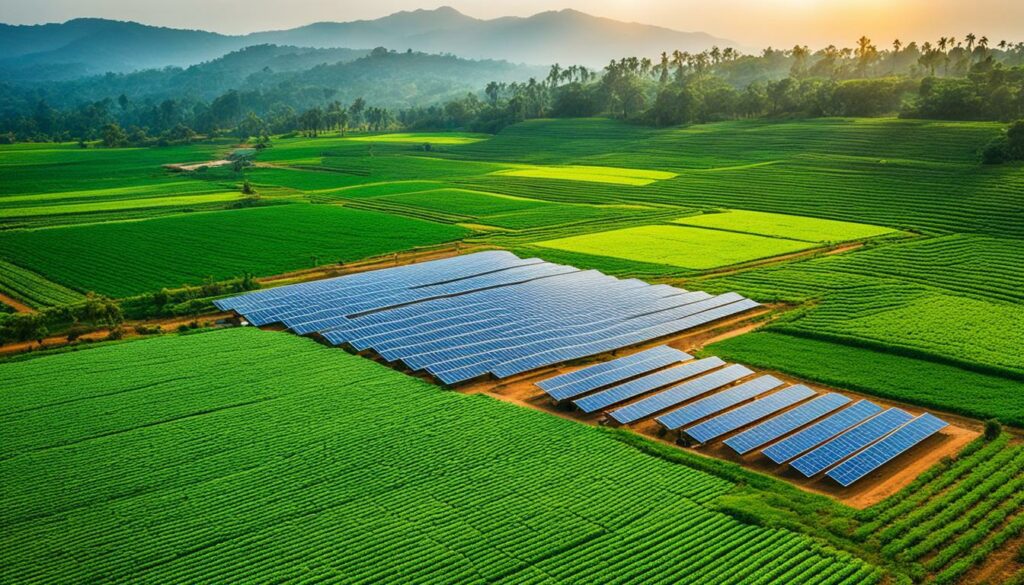
Places like Bihar face big issues with food waste. Almost 870 million people there still go hungry. And the waste is often because of poor postharvest tools, especially bad in harsh climates. With an expected food demand hike by 2050, we need to reduce this wastage.
The work led by ADMI and ADM Cares focuses on eco-friendly farming to reduce losses. In Bihar, farmers are given tools like leaf-colour charts to use nitrogen better. This lowers costs and cuts down on harmful emissions. They also get weather updates, making them more ready for farming challenges.
In India, keeping an eye on water use is key. Tactics like aquifer recharge and drip irrigation are crucial. They make sure water is there when needed and help farming last longer. Using eco-friendly machines and creating energy from farm waste also plays a big role in smart farming.
| Challenges | Climate-Smart Solutions | Impacts |
|---|---|---|
| Postharvest Losses | Leaf-Colour Charts, Improved Postharvest Technology | Reduction in Annual Crop Losses |
| Climate Variability | Weather Information Dissemination | Improved Planning and Resilience |
| Water Scarcity | Rainwater Harvesting, Drip Irrigation | Sustainable Water Management |
Smallholder farmers are key to sustainable agriculture. Over 500 million people around the world depend on their own farms for their living. They provide important crops like tea, palm oil, and cocoa to big companies such as Unilever. Yet, these farmers often lack training, money, and the right tools for farming. Technology is now offering them a chance to improve their methods.
Old ways of farming are hard work and not always reliable. Small farmers struggle because they can’t get the training and tools they need. They also face problems with money and proving the land they farm is theirs. All these things make it tough for them to grow their crops well and make enough money.
Technology made nearby is making a big difference for small farmers. Groups like ADM are helping introduce new tech to these farmers. For example, using Cropslist has helped farmers sell their products all over the world. This means more money for them. They also get advice on what crops to grow and how to do it in a way that looks after the land.
Getting feedback directly from people who buy their products is also helping farmers. It shows them what’s popular and how they can make their crops better. Using both new tech and good farming practices, these programmes are making farming a more professional job. They also help farmers make more money in a way that’s good for the environment. Working with organisations, NGOs, and companies, these projects are making life better for small farmers.
| Aspect | Traditional Methods | Technological Solutions |
|---|---|---|
| Reliability | Unreliable | Enhanced through data-driven platforms |
| Labour Intensity | High | Reduced with mechanisation |
| Market Access | Limited | Global access via platforms like Cropslist |
| Support and Training | Insufficient | Enhanced with educational resources |
| Income | Low | Increased by reaching global markets |
In Uganda, video technology is changing the game for agricultural training. These tools help farmers learn, even in areas with few resources. Videos mix old and new ways of teaching to reach more people and teach them better.
Agricultural videos are making a big difference in how farmers learn and work. They make it easy to share important farming knowledge. Videos are sometimes better than live demonstrations at teaching new things. They help farmers improve, especially if they don’t know much about the topic. Recent research shows that videos are as good as regular training for learning.
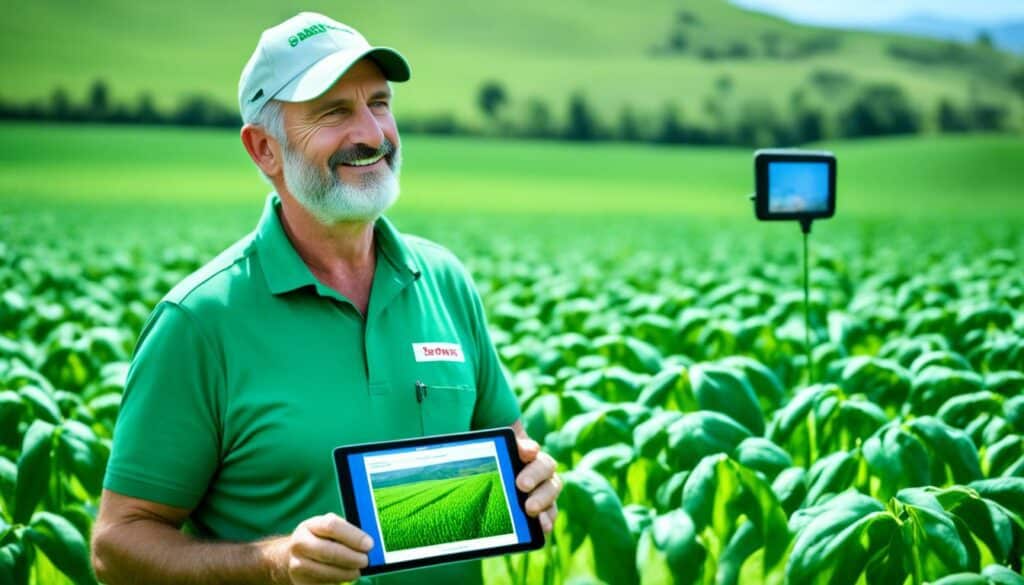
These videos are boosting how much farmers can produce. Using local actors and settings in the videos makes them more helpful and easy to understand. Gulu University and others have joined in, making farming techniques better and more productive. Thanks to small projectors, areas with no electricity can still access these videos, making learning possible for everyone.
| Method | Effectiveness | Target Audience |
|---|---|---|
| Traditional Lecture-Demonstration | High | All Farmers |
| Video Training Alone | Moderate | Low Prior Knowledge Farmers |
| Combination of Both | Very High | Low Prior Knowledge Farmers |
Access Agriculture is leading the way with these videos, making over 200 in different local languages. They work hard to keep the videos easy to use and up to date. Through this team effort, along with support from groups like the Swiss Agency for Development and Cooperation (SDC), farming knowledge is spreading fast. This helps men and women equally, making farming more sustainable for everyone.
The Kellogg’s Origins™ program shows a dedication to sustainable farming. It does this through partnerships and strong farming links around the world.
Kellogg’s Origins™ success is built on its many partnerships. By 2020, it had partnered with over 440,000 farmers, suppliers, and experts worldwide. These partnerships help make farming stronger against the challenges of climate, social issues, and finances.
The program has a big goal: to help one million farmers and workers by 2030. This target shows Kellogg’s determination to make farming relationships better worldwide.
The reach of Kellogg’s Origins™ is vast. By 2020, it had projects over 180,000 hectares. It focused on crops like wheat, corn, rice, cocoa, and sugar cane.
Their efforts in responsible sourcing reached 84% of the sugar cane goal in 2020. Also, they worked with 117 suppliers to improve environmental and social standards. This has helped 250,000 people by 2030.
The program also works hard to reduce its impact. It focuses on cutting Scope 3 emissions, particularly from ingredients and packaging. Kellogg’s checks its cocoa purchases from Cote d’Ivoire with Enveritas. This ensures they meet social, environmental, and economic standards, showing Kellogg’s commitment to ethical and sustainable sourcing practices.
| Ingredient | Responsible Sourcing Goal Achieved (2020) | Hectares Under Continuous Improvement (2020) |
|---|---|---|
| Sugar Cane | 84% | 180,000 |
| Wheat | 98% | |
| Corn/Maize | 98% | |
| Rice | 98% | |
| Potatoes | 98% | |
| Sugar Beets | 98% | |
| Fruits | 98% | |
| Palm Oil | 98% | |
| Cocoa | 98% | |
| Vanilla | 98% |
Ensuring there is enough food and improving what we eat are key in farming everywhere, but especially in the Global South. Making sure everyone has enough food and a variety of nutrients is crucial. It helps fight hunger and malnutrition.
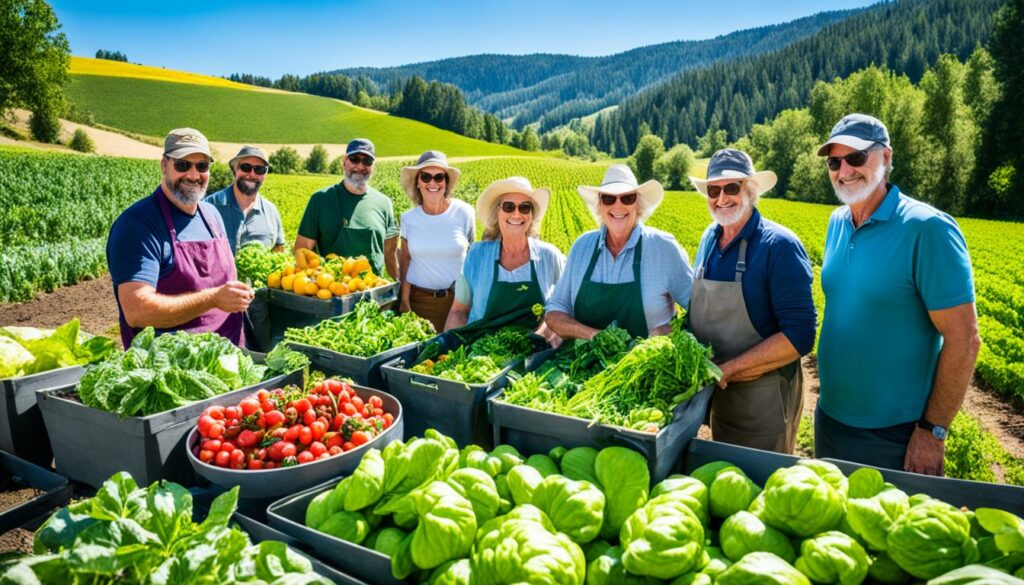
Using a mix of crops helps a lot in making sure there’s plenty of food. It means different nutrients are available for people to eat. Growing various crops together isn’t just good for the soil. It also makes meals more interesting, fighting against food boredom. Groups like NIFA work to encourage this mix of crops to make sure we eat well and the planet stays healthy.
Keeping pests under control is key to having enough to eat. Integrated pest management (IPM) uses many ways to keep pests away without harming the environment. Thanks to less pesticide use, crops and the earth stay healthy. NIFA’s support for IPM means our food is safer and more nutritious. This also helps reduce sicknesses, which is a big issue in some communities.
Adapting agricultural practices is key in tackling climate change and ensuring we have enough food. In the Global South, it’s vital to adopt methods like conservation tillage and efficient irrigation. These steps help reduce the impact of climate change and keep farming productivity up.
Conservation tillage is crucial for resilience against climate change. It’s known that about a quarter of greenhouse gases come from farming. By reducing soil erosion and improving water soak-in, this practice helps in keeping soil healthy. With a large part of the world’s soil in bad shape, it becomes essential for looking after our land in sustainable ways.
Using water wisely is very important in areas where water is becoming scarce due to climate changes. The way seasons are changing is affecting the growth of important foods worldwide. Methods like drip irrigation and collecting rainwater help save water. With more people needing food, we must find ways to use water carefully on farms.
By 2050, climate change might cause a big drop in the amount of food we can grow. But, by using conservation tillage and saving water in farming, we can fight against this. The key here is that small farmers in Asia and Africa are very important. If they start using these methods, it can really make a difference in dealing with climate change in farming worldwide.
| Challenge | Climate Change Resilience Practice | Impact |
|---|---|---|
| Soil Degradation | Conservation Tillage | Prevents erosion, maintains fertility |
| Water Scarcity | Water-Efficient Irrigation | Reduces water usage, increases yield |
| Rising Temperatures | Crop Rotation | Adapts crops to climatic shifts |
Working to protect the environment and keep a wide variety of living things is key to our planet’s future. One excellent method is agroforestry. It brings together different plants and animals on the same land to create a balanced system.
Imagine a field where trees, crops, and sometimes animals all live in harmony. In a study of 20 farms in the western Guatemalan Highlands, researchers looked at how well agroforestry worked. They compared 10 farms using Ecosystem-Based Adaptation (EbA) methods with 10 farms that used more traditional methods.
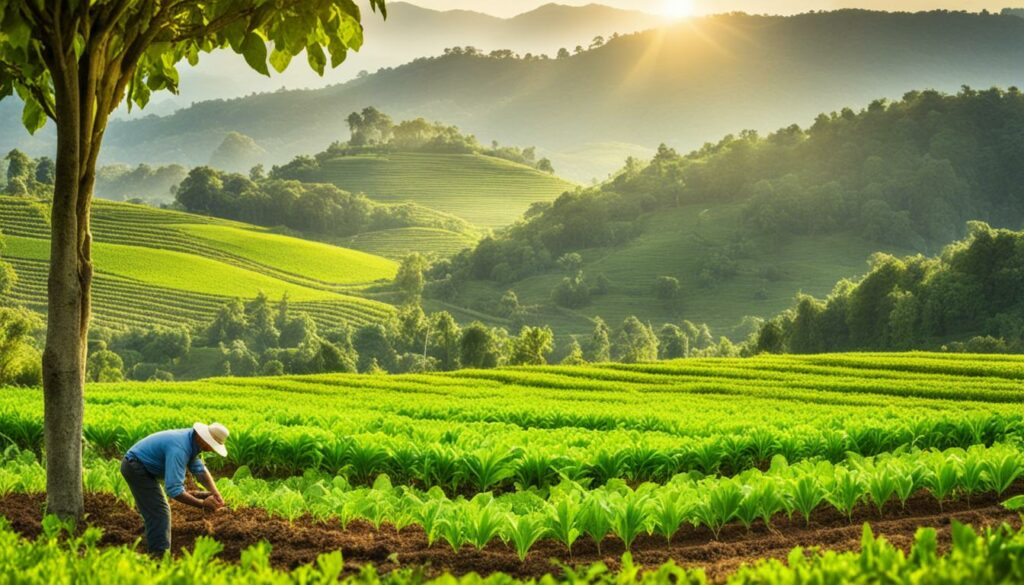
They found that setting up special areas around the farms helped friendly bugs. These areas showed 167 insects from 68 different types. In contrast, farms without these areas had fewer insects, just 87 insects from 34 types. Practices like planting crops in rows, carving steps into the land, growing different crops, and using natural fertilisers helped attract these insects. This is good because it helps protect the environment. It also makes farming better over time.
Looking after the soil and making safe places for wild animals is super important. A lot of the world’s land is used for farming. This can harm the balance of nature. To counter this, a project in Guatemala supported by the IKEA Foundation is trying to help nature. Since it began in May 2022, this project has been working to help plants and bugs that are important for keeping the environment healthy.
| Farm Management Practices | Biodiversity Outcomes | Ecological Benefits |
|---|---|---|
| Contour Farming | Reduces soil erosion | Improved soil structure |
| Terracing | Enhances water retention | Supports diverse agriculture |
| Crop Diversification | Increases species variety | Better resilience to pests |
| Organic Inputs | Reduces chemical pollution | Promotes healthier ecosystems |
The dangers of usual farming methods are clear. These common ways not only change natural homes but also hurt the wild animals that live there. By choosing to farm in more nature-friendly ways like agroforestry, we can protect wild places and the creatures that live in them.
Poverty alleviation through farming wisely is vital for growing rural economies. It helps communities by boosting incomes and growing towns, mostly in the Global South. Poverty rates have fallen with better farming methods since 1990. Today, only 14% live on less than $1.25 a day, from 53% in 1990.
The number of people living in extreme poverty, less than $1.25 a day, dropped from 1.7 billion to 569 million between 1990 and 2012. This fall should continue, lowering to 12% by the end of 2015. Yet, more live between $1.25 and $2.00 a day, showing we still have work to do. This shows how powerful good farming can be.
The Asia-Pacific area has seen great change thanks to smart farming practices. It reduced hunger by 236 million people, the biggest drop globally. But, nearly 500 million are still hungry, mostly in this region. This shows sustainable agriculture’s key role in fighting poverty and hunger.
Since 1990, this region has produced more food for each person, outstripping its population growth. Yet, some areas are seeing less food for each person. This is due to more people living in cities, more mouths to feed, and different diets. We need to keep pushing for smart farming to help these places and to support rural economic growth.
| Year | Population Living on Less than $1.25/day | Number of Undernourished Individuals |
|---|---|---|
| 1990 | 1.7 billion | 726 million |
| 2012 | 569 million | 490 million |
| 2015 (Projected) | 520 million | Not available |
To conclude, farming in a sustainable way helps both farmers and the fight against poverty. It boosts incomes and supports local economies, key for long-term growth in the Global South and elsewhere.
Efficient management of resources is a key element in sustainable farming. It’s all about using modern methods to make the most of what nature gives us. This approach helps farms to be sustainable for the environment, the economy, and society. Drip irrigation and organic farming are two such efficient and sustainable methods.
Drip irrigation is a smart way to water crops efficiently. It stands in contrast to traditional flooding, which ends up wasteful. With drip irrigation, plants get water right at their roots. It cuts water use by 20-40%, ensuring none is wasted. This approach helps crops grow better, saves water, and stops soil from washing away. It’s key for making farming sustainable in places where water is scarce.
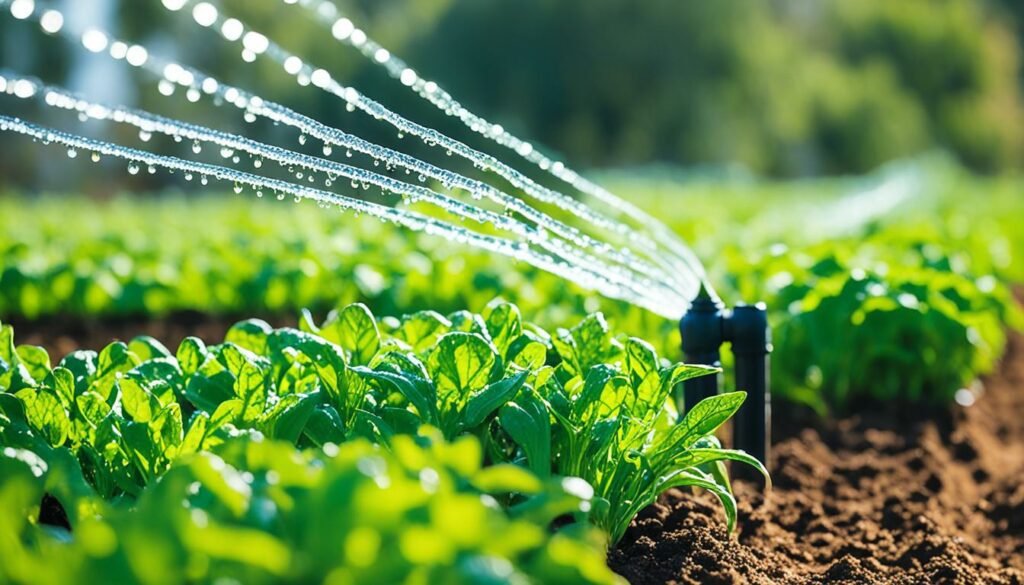
Organic farming plays a big role in using resources wisely. It uses natural methods to improve soil and keep it vibrant. Without using harmful chemicals or GMOs, it keeps ecosystems healthy and lessens pollution. Organic farming also looks after the soil for the long run. This leads to more crops and saves natural resources. It’s an important part of making farming last for future generations.
| Method | Water Usage | Soil Health | Crop Yield | Environmental Impact |
|---|---|---|---|---|
| Drip Irrigation | Reduced by 20-40% | Positive, less erosion | Increased | Minimized |
| Organic Farming | Optimised | Enhanced fertility | Increased | Reduced pollution |
Drip irrigation and organic farming are at the heart of using resources well in agriculture. They save resources and help farming continue for the long term. By balancing productivity with environmental health, these practices show a way forward for sustainable agriculture.
Focusing on women’s empowerment in agriculture is key to sustainable growth, especially in the Global South. Offering women farmers access to training, resources, and chances to lead has brought big changes. Their lives have gotten better, and so have their community’s economic conditions.
Training is vital for women working in agriculture. It gives them the skills to use new technology and fight climate change. Studies show that with training, women increase the money they bring home.
Getting access to credit is also hard for women. They often don’t own the land they work on and struggle to get loans. With better access to credit, these farmers can improve their crops, use better tools, and stay productive in the long run.
Allowing women to lead in agriculture is crucial. The WEAI index, introduced in 2012, helps measure how empowered women are in different areas. It looks at gender equality and key decisions within families.
Used in over 56 countries, the WEAI index is a global yardstick for success in women’s agriculture empowerment. It has shown that investing in women’s leadership pays off economically. The index is also widely used in academic studies, highlighting its importance in gender equality research.
| Measurement | Benefits |
|---|---|
| Access to Training | Technology adoption, reduced losses, climate resilience, income growth |
| Access to Credit | Improved outputs, access to new technologies, long-term productivity |
| Leadership Opportunities | Economic empowerment, enhanced decision-making power, gender parity |
Sustainable farming helps keep us fed, our economy sound, and our traditions alive. Mixing old farming ways with new ones lets communities keep their unique culture. At the same time, they help the environment.
For example, the USA lost a lot of its wetlands to farming and development. Now, most of its waterways are controlled by people. This changes our waters a lot. We need new ways to farm that keep old traditions in mind.
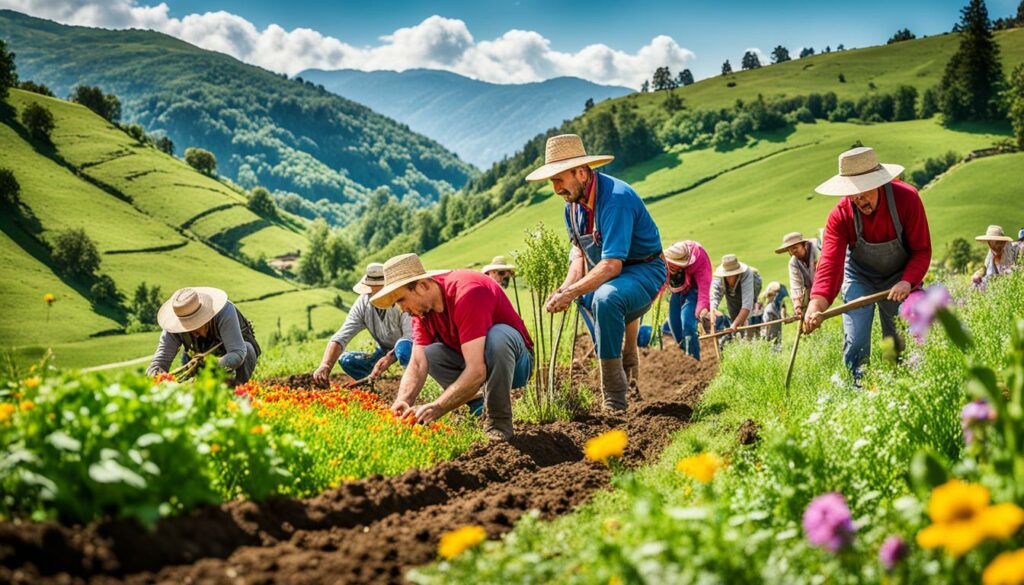
In China, they changed many wetlands into farmland. This harmed nature’s ability to control floods. It shows why we must protect farming methods that are both green and productive.
Japan has been losing its rice fields to cities. Places like Koshigaya City are growing, taking away from old farming spaces. In Europe, more food is needed, so natural places are turned into farms. This can hurt local wildlife and old farming ways.
Keeping these old farming ways alive helps everyone. It keeps people fed, nature healthy, and our traditions intact. They can also help fight the bad impacts of climate change.
There’s a big talk coming up soon in Brussels, marking on 24/11/2023. Experts will share ideas on how farming can help save our traditions and nature. They’ll talk for 15 minutes, showing how vital old farming methods are for our future.
Creating sustainable ways to farm is vital for growth in the Global South. These plans don’t just make farming better. They also focus on keeping our land healthy for the future.
Using smart farming methods, like growing different plants together, helps the economy. This makes the soil better and our food grow more. Using less soil-disturbing ways helps keep the ground healthy too.
Reducing chemical use in farming through integrated pest management is key. It saves money and is good for the planet. Mixing crops with animals can also make the farm more profitable. It uses resources better.
Getting everyone in a community to work together can mean big changes. Trees, for instance, are good for the land and add to what farmers earn. This is just one way that farming can serve both people and the planet.
Farms that look at the whole picture of their land do well. They have less pollution and more life. They keep water better and their crops are healthier.
| Practice | Benefits | Implementation |
|---|---|---|
| Intercropping | Improves soil health, pest control | Plant multiple crops concurrently |
| Cover Cropping | Prevents erosion, replenishes soil nutrients | Plant cover crops post-harvest |
| No-Till Farming | Reduces erosion, enhances soil health | Minimise soil disturbance |
| IPM | Controls pest populations, reduces pesticide use | Combine biological, cultural, physical and chemical tools |
| Agroforestry | Environmental benefits, additional income | Integrate trees into farming operations |
These farming methods, when used together, can boost the economy and help communities grow. They pave the way for a strong farming future.
Using sustainable farming is hard, especially in places with a lot of people and food worries. Changing to sustainable ways is tough because of money, not knowing how, and being used to other methods.
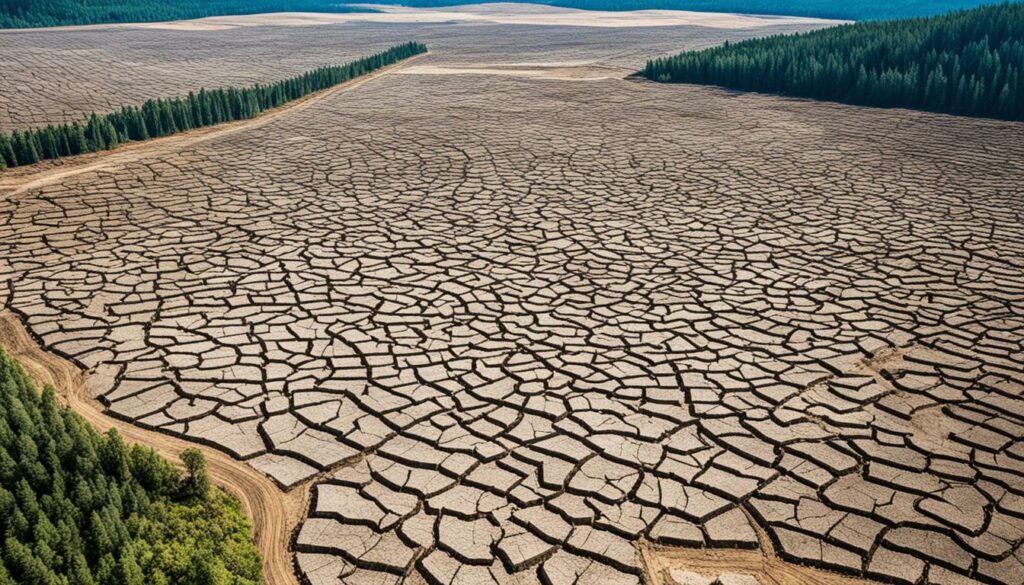
A lot of the world’s land, about 40%, is used for farming. There’s a big difference between regular farming and sustainable farming. Regular farming can hurt the environment. For example, it uses a lot of chemicals that can pollute the soil, water, and air, affecting food’s safety.
Some farmers are mixing organic stuff with a bit of the usual fertilisers to try and farm better. This mix makes it easier for the soil to stay healthy. Doing this helps us keep making enough food in a way that doesn’t hurt nature.
The weather changing makes farming even harder. Many farmers have tried new ways, like farming without turning the soil a lot or planting other plants in between. But, a lot of them say they can’t just stop using so many chemicals.
Most farmers didn’t use fewer chemicals, and many didn’t check their soil’s health. This shows that many are not ready to change and might not know enough about better ways.
Small farmers in poor countries find it the hardest to change how they farm. They often don’t use new technology because they can’t afford it. This keeps them from making more food or money.
Teaching farmers better ways and giving them more information could help. Nine out of ten farmers want to farm better. But, they need more guidance and help managing the change to greener farming.
Money worries are the biggest issue for most farmers trying to be sustainable. Governments should help with this to make it easier for everyone to farm in a way that doesn’t cause harm.
To sum up, moving to sustainable farming is tough but really important. We all need to work hard to help farmers overcome the problems they face. By doing this, we can all enjoy better and safer food while taking care of the planet.
Farmers need more time, information, and management to farm in a sustainable way.
It’s important to keep working hard to support farmers in making their farming sustainable. With the right help and advice, more farmers can start using methods that are good for the earth and for the people.
The future of farming is about to change a lot with new trends and inventions. The world will need 70% more food by 2050, pushing for better ways to farm. This means using technology and updating rules to make farming more effective, productive, and kind to the planet.
Farming is getting smarter with the help of tools like drones, robots for picking crops, and IoT devices. These help farmers watch over and manage their fields carefully, using less resources but getting better results. For example, ICL’s StartUp Agmatix uses artificial intelligence to give farmers tips, making farming more environmentally friendly. The use of smart farming tools is growing fast. The market for precision farming could be worth over $16 billion by 2028. This kind of technology makes farm machines more accurate. This not only helps farmers but also makes the soil healthier.
New tech is also tackling the big issue of wasted food, which makes up a big part of food loss worldwide. Thanks to things like food-sharing apps and clever storage solutions, plus ICL’s treatments that keep food fresh longer, we can cut down on how much food we waste.
To really benefit from these new trends, agriculture needs strong rules and government support. Policies need to encourage farming in ways that help the land and our food. This includes things like farming that is good for the soil and using water wisely. Rules should also help farms use new technology to cut down on waste and do better.
Encouraging the making of food in ways that are good for people and the earth is important. This is what many people want, according to Mintel. As we focus more on health and the environment, we might eat more plant foods and foods made in labs. This can make farming more varied, with new crops like soybeans becoming more popular.
To sum up, it’s crucial to adopt new farming methods and use supportive rules. By making the most of technology and updating our ways, we can farm smarter. This helps farms be more productive, better for the environment, and able to face any challenges.
It means farmers use methods that are kind to the planet. These ways help the land produce for a long time. They also focus on keeping our environment safe and fair for everyone.
Buying local food helps farms use good practices. It also means the money stays in the local area. This helps the community and makes sure there is enough food for all. It fights problems in farming and makes us healthier and stronger together.
Farmers face tough times like drought and losing crops after harvest. They also might not have the newest tools. This can stop them from growing food in a good way.
Using smart farming can fight the bad effects of the weather. It makes farms stronger and can help in places like Dih Sarsauna, Bihar. It makes sure the land and ways to grow food can last.
Technology made by locals can help small farmers do better. It changes hard work into smart work. This means more food and more money for these farmers.
Videos that teach farming help farmers share ideas. They make farming better, with more food and knowledge. This helps everyone in the end.
Kellogg’s joins with others to make farming better. It helps the earth, farmers, and their families. This program reaches over 322,000 farmers all around the world.
Using many kinds of crops means less food problems. It makes food more healthy and safe. This helps make sure there is enough food for everyone.
Some methods like saving water and not disturbing the soil help. They keep the land good, use water better, and keep making food in a smart way.
Agroforestry uses trees to make farms better. It helps our land, makes the soil rich, and gives animals a home. This is how it helps keep nature safe.
Farming that looks after the future makes more money. It helps whole communities and makes places grow stronger. This type of farming is steady and good for everyone.
Looking after the earth better means more food and saving what we have. It keeps farming going for a long time in a good way.
Giving women what they need in farming makes everyone better off. It helps villages and makes the money situation stronger. This is good for all.
Using old ways with new ones helps the earth and our memories. It leads to a future that is both rich in tradition and strong for tomorrow. This is how we remember and make it last.
Helping farming grow the right way makes a powerful and fair system. It brings people together for a lasting and caring future in farming.
Farmers need help to use better ways. They might not know how or be able to change. Supporting them is key to a brighter future in farming.
The future will be full of new ideas and ways to grow food. It will keep getting better and safe for the world we live in.